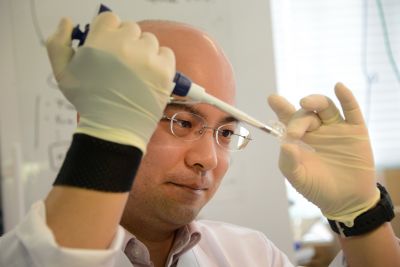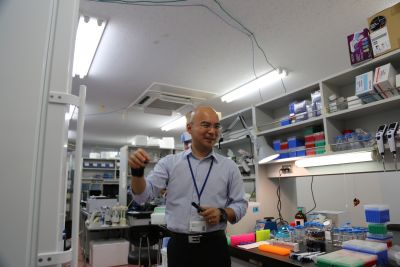TSUKUBA FUTURE
#044 A "Rescue Team" for Epigenomic Analysis
Associate Professor MURATANI Masafumi, Faculty of Medicine

Rapid improvements in the performance of DNA sequencing devices (also called "sequencers") are bringing about remarkable advances in genetic and genomic research. However, each research project has some parts that will not work without ingenuity and creative thinking. Moreover, there are limits to what a single person or lab can accomplish. Professor Muratani is making a name for himself as a special rescue team member who can lend a hand in solving vital issues in genetic analysis that require expert skill.
Since the sequencing of the human genome (the complete set of human genetic information), the technology has become so widespread that there now are even companies that will perform genetic testing for customers. It would seem that we have now uncovered the secrets of human genes and know everything about them. However, that is not the case. The cells in our body all have the same set of genes (called the "genome"). Even still, some cells become skin whereas other cells become the liver. This is because not all genes in cells are expressed. There are complex mechanisms that turn the right genes on and off and function wherever they are needed.
If a gene in the wrong area is turned on at the wrong time, it could cause the cell to go haywire and become a cancer cell. Professor Muratani has discovered that a gene that functions abnormally in stomach cancer cells is actually a gene that serves an important function in the process of constructing the human body and has located the gene region containing the gene's "on" switch. The process by which genes are switched on and off is called "gene regulation" and the system that regulates this process is called the "epigenome." Professor Muratani made his aforementioned discovery after developing a method for analyzing the epigenome using microsamples.

Professor Muratani is happy that he can apply his special talents to his dream job.
Professor Muratani was fascinated by researchers doing experiments in their white lab coats. After graduating from the University of Tsukuba, he researched how proteins are synthesized from DNA while studying abroad in the United States. After that point, genomic research in various animals became a highly active field. This type of research is conducted by dividing the work among researchers in a large research group. While working in business development during his postdoctoral fellowship at the Genome Institute of Singapore, seeking to be more than just a cog in the machine, he thought long and hard about what unique skill he alone could offer the research group. That was when he came across a job doing analysis of trace quantities of clinical specimens. We tend to associate the word "clinical specimen" with pathological tests to determine whether a tumor is benign or malignant. In this context, however, it refers to analysis of tissue specimens with the goals of discovering direct mechanisms of disease and developing drugs to treat them. To do this, we need to fish out the causative genes that trigger disease when switched on. It might seem like automated methods for genetic analysis should make this an easy task, but that is most definitely not the case. Methods that can be used to detect genes that have mutated cannot be used to detect dormant genes that become harmful when switched on. This is where Professor Muratani comes in. Professor Muratani has learned a variety of experimental techniques including bioinformatics (i.e., analysis of genetic information by computer) , various research materials, for example yeast, cultured cells, stem cells, mice and clinical specimens, and has amassed a broad range of experience through collaborative research with researchers and companies in other fields. Using the expertise he has gained as a professional collaborative researcher, he prepares microsamples and pulls out the target genes to find the information he is looking for, purifies the samples and runs them through a next-generation sequencer, and then analyzes the resulting data (using informatics). His selling point is that he can complete this entire process from start to finish. Professor Muratani jokingly refers to himself as a "one-stop genomics service" or an "international rescue team."

He is currently sharing lab space due to construction to reinforce his lab against earthquakes.
However, as long as he has the bare minimum of equipment required, he can conduct his research anywhere, even in a corner of a lab.
University of Tsukuba Hospital is home to an organization called the Tsukuba Human Tissue Biobank Center. This organization provides the remnants of tissue and blood samples collected for clinical purposes, enabling researchers to use specimens with a well established origin. Professor Muratani is working with the Diagnostic Pathology Research Group in the Faculty of Medicine at the University of Tsukuba (Department of Pathology) to conduct research on mechanisms of cancer onset using lung cancer cells and other specimens. He is particularly drawn to the mystery of how cells become cancerous before cancer is diagnosed. In addition to these efforts, he is a member of a research team studying the "space mice" that are to be sent up to the Japanese Experiment Module "Kibo" of the International Space Station in 2016 and is the lead researcher for a project on genomic/epigenomic analysis of plasma nucleic acids that will analyze blood samples of astronauts living in space. While in Singapore, he was impressed by the nation's proactive stance toward supporting businesses launched by young citizens. In Japan, there could be a separate support system designed to fit the country. In light of his personal experiences, Professor Muratani wants to help students and postdoctoral fellows in his own way. He feels that this is another duty of his as a rescue team member.
Article by Science Communicator at the Office of Public Relations


